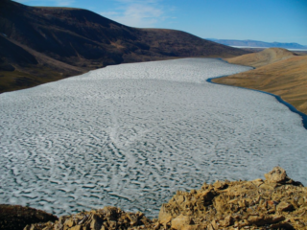Rodriguez, J. A. P. et al. Tsunami waves extensively resurfaced the shorelines of an early Martian ocean. Sci. Rep. 6, 25106; doi: 10.1038/srep25106 (2016).
If you’ve seen The Martian, you might think of Mars as a vast, inconceivably arid desert. And, with the exception of the frozen water at the poles, you would be right (although there are trace amounts of water in the soil). The majority of the planet is certainly dry today, but scientists suspect there were once vast oceans on its surface.
Evidence for Martian oceans comes primarily from telescope and satellite observations. The data make a compelling case for large bodies of surface water. But there is still vigorous debate about how much and where they might’ve been located.
One popular theory suggests that an ice-covered ocean occupied the high Northern plains during the Hesperian epoch, about 3.5 billion years ago. Proponents of this idea point to a large sediment deposit in the area, known as the Late Hesperian lowland unit (or lHl), that consists mostly of water-ice. But, if there were an ocean, one would expect to see a shoreline shaped by waves.
Enter Dr. Jose Rodriguez of the Planetary Science Institute and an international group of collaborators. They performed some clever analysis of satellite imagery and numerical modeling to locate plausible shorelines. The group also suggested a possible mechanism for shaping these ancient shorelines: gigantic, extraplanetary TSUNAMIS!

Mapping ancient shorelines on another planet is, as one would expect, very challenging. To do so, Dr. Rodrigeuz and his team combined data from three different satellites orbiting the Red Planet. They used thermal infrared data from the Mars Odyssey Thermal Emission Imaging System to differentiate several types of sediments on the surface. Image data from the Mars Reconnaissance Orbiter Context Camera was used to identify large surface features. Finally, elevation information was extracted from the Mars Global Surveyor – Mars Orbital Laser Altimeter.
Dr. Rodriguez was able to combine all this information using special mapping software called GIS. Analysis of the resulting maps revealed two possible paleo-coastlines along the edges of the northern lowland (fig 1). The team points out a number of telltale features including how sediments are distributed and the existence of backwash channels. These qualities are consistent with how Earth’s coasts are shaped: sediments are washed on-shore by waves and water flows back out to sea when it ends up inland.

The combined satellite data also revealed large boulder fields around the proposed ocean boundary. The boulders are distributed around, but not on top, of high mesas. This indicates that they scattered there by floodwaters being diverted around the elevated landmasses. Furthermore, the boulders are huge, with some as large as 10 meters (30 feet) across (fig 2).
The only kind of wave that could produce such features is a tsunami. Dr. Rodriquez developed a model to determine how large such a tsunami would have to be to create the features the team observer. The answer is a really, really big one. As in, bigger than anything we’ve seen on Earth.
Terrestrial tsunamis occur when an earthquake happens offshore. The quake produces a pulse of propagating energy that shoals when it reaches land, creating a huge, destructive wave. The results are often devastating for the communities in its path.
Dr. Rodriguez suggests that the Martian tsunamis were caused not by earthquakes, but by large impact from a meteor. To generate the amount of energy need to move the boulders, he calculated that the impact would have made a crater 30 km (18.5 mile) across. The resulting tsunamis would cause water to wash hundreds of kilometers on shore.
With these estimates in hand, the team turned back to the satellite data. They were able to identify 23 candidate craters in the Martian paleo-ocean. Of these, 7 were of the right size to cause a tsunami of appropriate size.

The debate about Martian water is, of course, far from over. But Dr. Rodriquez and his team have slotted a piece into the puzzle: evidence of shorelines of an ancient, Martian ocean. Moreover, the study is a great example of how interdisciplinary collaborations can yield exciting science. If you check out the “author information” section of the paper, you’ll see the breadth of disciplines represented. From astronomers, to hydrologists, to image processors — all of them had an important role!
Eric is a PhD student at the Scripps Institution of Oceanography. His research in the Jaffe Laboratory for Underwater Imaging focuses on developing methods to quantitatively label image data coming from the Scripps Plankton Camera System. When not science-ing, Eric can be found surfing, canoeing, or trying to learn how to cook.



One thought on “Paleo-oceanography from satellite data reveal ancient tsunamis…on Mars?!”